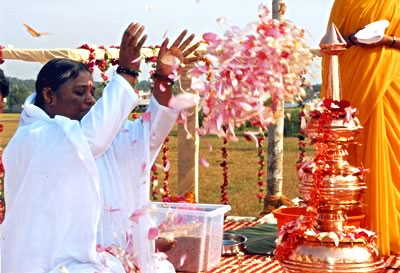Brahmasthanam Temple

Amma inaugurates the Brahmasthanam Temple
in Thrissur, Kerala, India, 2005.
The temple is truly the cradle of Indian culture. Most of the arts and sciences that developed in India originated in temples, and were nourished by the temple culture down through centuries. Though there were no temples in the vedic period, the source of the temple concept is the Vedas themselves.
In a divine vision, Amma clearly saw how she could mitigate the miseries of modern man by reviving and revitalizing the age-old tradition of temple worship. The Brahmasthanam (the abode of Brahman) temple is the outcome of that divine vision. This new type of temple with a new mode of worship was created to alleviate human suffering, educate people in the true principle behind temple worship, show the unity underlying diversity and help unfold the divinity within each one of us. The worship in the Brahmasthanam temple focuses on the importance of unselfish love for God, the value of performance of worship and rituals performed by devotees themselves, the special power of congregational yagnas (collective worship), and the performance of daily pujas conducted according to the injunctions of the Shastras (scriptures). Amma has established Brahmathanam temples in India in her numerous ashrams, where people can have pujas done on their behalf in order to alleviate the suffering in their lives caused by malefic planetary influences.
The pujas are performed on behalf of those who request them by Amma's monastic disciples at Amma's Brahmasthanam temples, or in the case of the Kali puja, at Amma's ashram, Amritapuri. Some of the pujas are elaborate and can take anywhere from one to five hours or more.